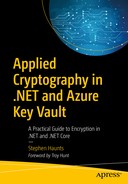Index
A
Access control lists (ACLs)
Advanced Encryption Standard (AES)
AesManaged and AesCryptoServiceProvider
brute-force attacks
different key
encryption mode
initialization vector
key
padding
permutation box (P-box)
rounds
substitution box (S-box)
working process
AesManaged and AesCryptoServiceProvider
Ashley Madison
Asymmetric encryption
key links
public key cryptography
Authentication
Azure Key Vault
app registration
configuration
costs
creation
digital signing
helper class
helper method
RSAPKCS1SignatureFormatter and DeFormatter classes
Sha256() method
verify method
directory
hardware mode
hardware-protected key
“Hello World” application
client library
CreateKeyAsync method
DecryptAsync method
EncryptAsync method
GetAccessTokenAsync method
helper code
IKeyVault, KeyVaultBase, and KeyVault
IKeyVault method
keyId
KeyVault class
NuGet package
SetSecretAsync method
VaultAddress parameter
Verify method
HSM hardware
hybrid encryption
AesEncryption class
AES helper method
CryptographicException
cryptography primitives
DecryptAsync method
EncryptData method
EncryptedPacket class
HMAC key
HMACS and digital signatures
HybridEncryption class
MyKey method
private signing key
results of
Sign method
Verify method
iterations parameter
key management options
keys
vs.
secrets
local key wrapping
management
multiple environments
benefit of
code, configuration files/databases
financial data
GetSecretAsync method
KeyVault.cs class
local key wrapping (
see
Local key wrapping)
production systems
separate instances
storing and retrieving secrets
test and production environments
valuable production data
nShield
password protection
hashing function
helper class
key class
lines of code
PBKDF2
protect salts and iteration values
source code
steps to steps process
patterns
PFX certificate file
secret code
signing and verification
software mode
software protected key
B
Brute-force attacks
Byte arrays
C
Cipher block chaining (CBC)
Ciphertext feedback (CFB)
Ciphertext stealing (CTS)
Cryptographic service provider (CSP)
Cryptography
asymmetric encryption
authentication
Azure Key Vault
configuration
key management
local key wrapping
multiple environments
password protection
patterns
signing and verification
Caesar cipher
ciphertext
data integrity
definition
digital signature
encryption technique
enigma and mechanical ciphers
hashing function
history of
hybrid encryption
modern cryptography (
see
Modern cryptography)
monoalphabetic substitution cipher
non-repudiation
polyalphabetic cipher
key phrase
moveable
stationary
Vigenère cipher
public and private key
random numbers
storing passwords
symmetric encryption
D
Data breaches
consequences
cryptographic primitives
developers
financial loss
Have I Been Pwned
legal action
.NET Core 2
.NET Standard 2.0
network protection
regulatory impact
reputational damage
sensitive/confidential data
website
Data Encryption Standard (DES)
56-bit symmetric key
block cipher
Feistel structure
history of
internal structure
key schedule
Triple DES
Data integrity
DES Challenge (DESCHALL)
Digital signatures
algorithms
creation
cryptography
internet websites
.NET
byte array
document modification
implementation
key generation
source code
valid options
verification
non-repudiation
process of
public and private key
verification
E, F
Electronic codebook (ECB)
Enigma machine
G
General Data Protection Regulation (GDPR)
Graphics processing units (GPUs)
H
Hardware security module (HSM)
Hashes
Hash function
HMAC verifies
MD5 message digest algorithm
message
properties of
SHA family
storing passwords
calculation
cryptographic hashing
GenerateSalt
combine method
properties
results of
salt value
tables
unique hash code
Hash message authentication codes (HMACs)
authentication key
dictionary attack
hash collision
hashing function
output process
process of
Hybrid encryption
authentication
cryptographic primitives
cryptography
digital signatures
AssignNewKey method
benefits of
DecryptData method
EncryptedPacket
integrity
process
VerifySignature
integrity
Buffer.BlockCopy operation
byte arrays
EncryptData method
EncryptedPacket class
EncryptedPacket object
HMAC
MD5, SHA-1/SHA-2
process option
session key
non-repudiation
symmetric and asymmetric (
see
Symmetric
vs.
asymmetric encryption)
I, J, K
Initialization vector (IV)
Integrity
L
Local key wrapping
AesCryptoServiceProvider
benefits
DecryptAsync
GenerateRandomNumber method
key rotation and versioning
key sharing benefits
KeyVault class
master key
multiple tenants
public key
SecureRandom class
M
MD5 message digest algorithm
Modern cryptography
authentication
blockchain
confidentiality
cryptocurrency
data integrity
non-repudiation
systems/websites
Monoalphabetic substitution cipher
Moore’s law
N
Non-repudiation
O
Optimal asymmetric encryption padding (OEAP)
Output feedback (OFB)
P, Q
Payment Card Industry–Data Security Standard (PCI-DSS)
Password Based Key Derivation Function (PBKDF2 )
Personally identifiable information (PII)
R
Random numbers
deterministic nature
RNGCryptoServiceProvider class
RtlGenRandom function
pseudorandom
symmetric and asymmetric encryption keys
Rivest-Shamir-Adleman (RSA)
benefits
disadvantage
encryption and decryption
.NET
cryptographic service provider
encryption and decryption
in-memory keys
XML-based keys
public and private key
RSAParameters properties
XML-based keys
S, T, U, V, W, X, Y, Z
Secure Hash Algorithm (SHA)
Side-channel timing attack
Software as a service (SaaS) solution
Storing passwords
cryptography
encryption and decryption
hashes (
see
Hash function)
key derivation function
computer processors and GPU’s
derived key
GenerateSalt
hash/encryption process
HashPassword method
Moore’s law
.NET object
PBKDF2 timings
screenshot
system creation
Symmetric
vs.
asymmetric encryption
advantages
AesEncryption class
AES session key
DecryptData method
decryption operation
decrypt process
Encrypt and Decrypt method
EncryptedPacket
process
results of
RSA benefits
sharing keys
short methods
step by step process
Symmetric encryption
advantage
fast
very secure
AES (
see
Advanced Encryption Standard (AES))
asymmetric encryption
DES (
see
Data Encryption Standard (DES))
disadvantage
compromised
symmetric key
encryption and decryption
.NET
AesCryptoServiceProvider
AES encryption results
CryptoStream object
Decrypt data
DESCryptoServiceProvider
DES source code
Encrypt method
FlushFinalBlock
initialization vector
keys and initialization vectors
key variation
MemoryStream
result of
TripleDESCryptoServiceProvider
..................Content has been hidden....................
You can't read the all page of ebook, please click here login for view all page.
